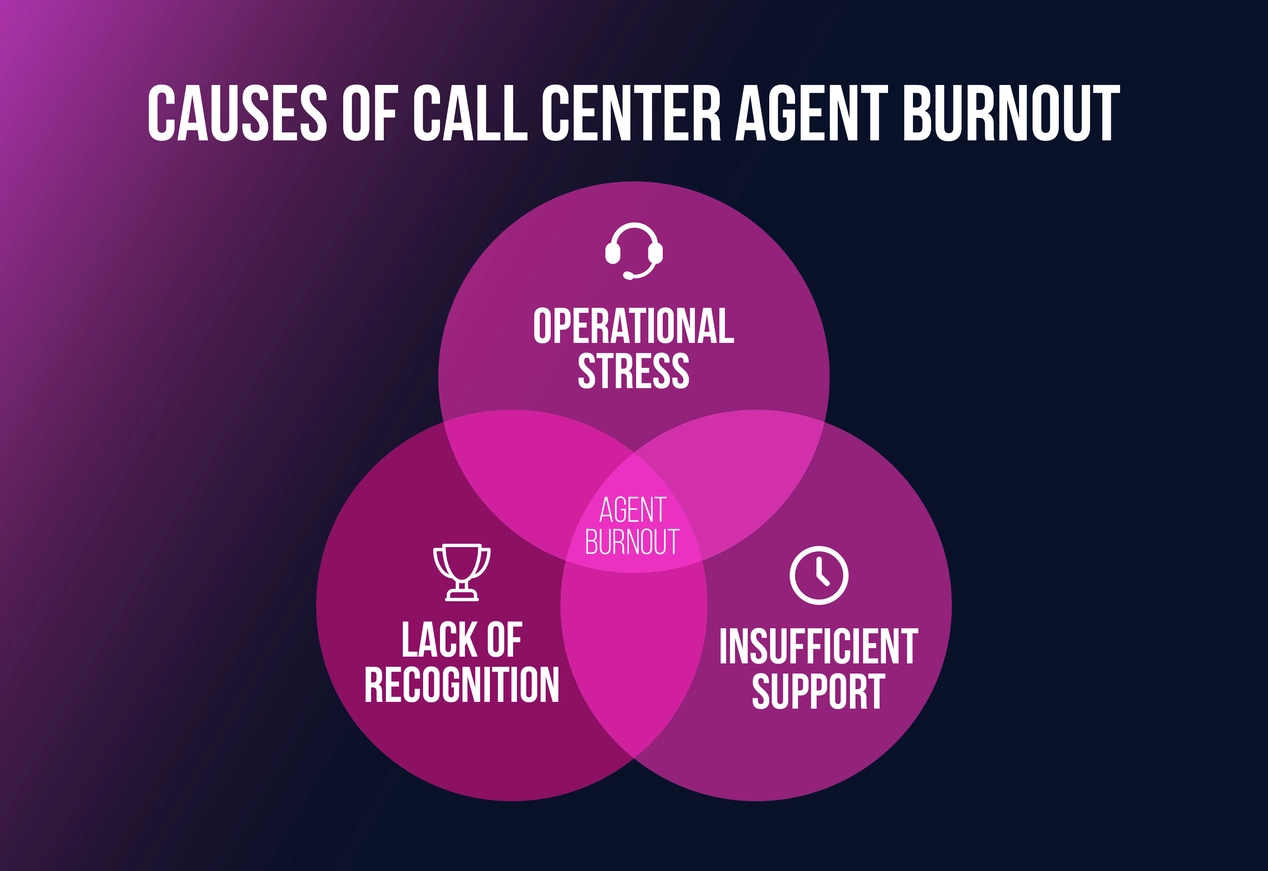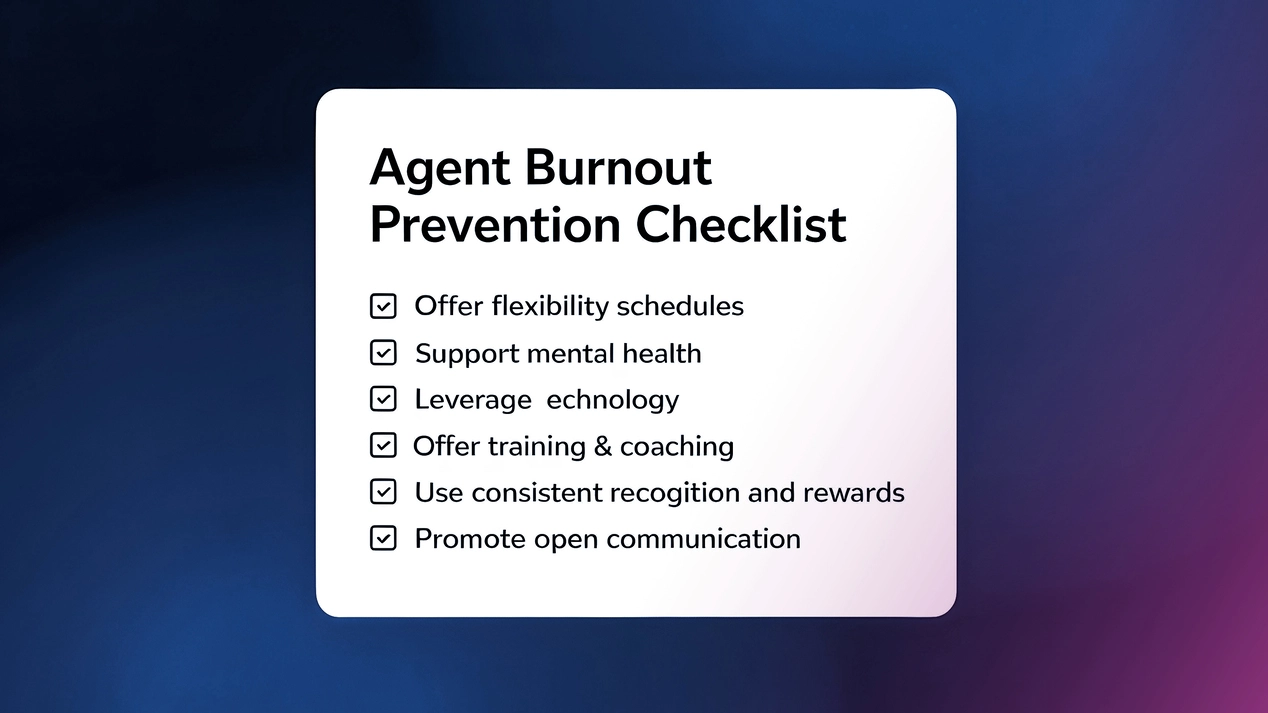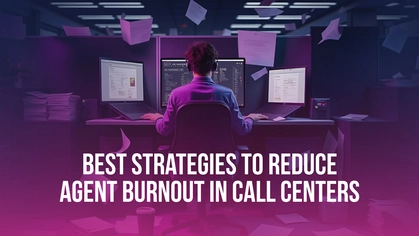
To remain competitive, organizations must prioritize their workforce's psychological and emotional needs just as much as they do productivity and performance metrics. This means putting the well-being of call center workers and their overall experience first in operational decisions.
This guide provides clear insights into the main causes of burnout. It also discusses its long-term effects and offers practical strategies to fight it. When implemented strategically, these solutions not only improve employee satisfaction but also strengthen the entire customer service ecosystem.
What is Agent Burnout in Call Centers?
Agent burnout is more than just feeling tired. It is a complex issue caused by long-term stress at work without enough support. It's common in places like contact centers.
Agents must handle a lot of emotional work. They need to solve problems quickly and meet tough goals.
What Are the Key Causes of Burnout for Call Center Agents?
- Excessive workload and unrealistic targets: Back-to-back calls, long shifts, and demanding quotas create physical and mental fatigue.
- Insufficient rest and recovery time: Not having breaks stops agents from relaxing and recovering during or after stressful interactions.
- Lack of schedule flexibility or control: When agents can't influence their schedules, it increases their sense of helplessness.
- Minimal recognition or feedback: Efforts go unnoticed, causing demoralization.
- Emotional fatigue: Dealing with angry or distressed customers day in and day out takes an emotional toll.
The following Venn diagram distills these five individual causes into three overarching factors, offering a visual summary of how they overlap and compound to drive burnout among call center agents.

What Are the Key Signs of Agent Burnout?
- A visible decline in enthusiasm, motivation, and energy
- Mood swings, frustration, or increased sensitivity to feedback
- Higher frequency of mistakes and longer average handling times
- More frequent sick days or unplanned absences
- Psychosomatic symptoms such as headaches and insomnia
Recognizing these red flags early allows leadership to take preemptive action before the problem becomes systemic.
How Burnout Impacts Call Center Performance
Unchecked agent burnout creates ripple effects throughout the organization:
- Decreased Productivity: Burnt-out agents struggle to maintain focus and consistency. Performance indicators such as call resolution time and first-contact resolution rates often suffer.
- Poor Customer Experience: When agents feel disengaged or exhausted, they degrade in tone, patience, and problem-solving abilities. This diminishes brand reputation and customer loyalty.
- Attrition and Hiring Costs: Agents who feel chronic stress are more likely to leave. This creates a costly cycle of hiring and training new staff.
- Weakened Team Dynamics: Burnout spreads. Team morale drops, collaboration falters, and internal conflicts may increase.
Ultimately, these factors compromise the sustainability and scalability of your contact center operations. That’s why investing in prevention is a competitive advantage.
How to Prevent Agent Burnout in Call Centers?
1. Flexible Scheduling and Work-Life Balance
Flexible scheduling is one of the most powerful tools for improving call center well-being. By empowering agents to customize their working hours around personal obligations or energy levels, companies demonstrate trust and respect.
Practical Work-Life Initiatives for Call Center Agent Well-Being
- Remote work policies: These reduce commuting stress and enable a better home-work balance.
- Shift swapping systems: Allowing agents to trade shifts builds autonomy and peer support.
- Compressed workweeks: Letting agents work four longer days instead of five standard ones.
- Floating days off: Used for personal matters, birthdays, or mental health days.
Work-life flexibility not only prevents agent burnout but increases satisfaction, motivation, and loyalty. It makes the contact center a great place to work. This helps companies attract and keep talented employees.
2. Effective Stress Management Programs
Stress in a call center is inevitable. But, its impact can be mitigated through thoughtful intervention. A culture that equips agents with mental tools to manage stress ensures long-term stability.
How to Manage Stress Among Call Center Agents?
- Structured stress relief workshops: Sessions on topics like emotional regulation, cognitive reframing, or breathwork techniques.
- Mindfulness practices: Incorporate short daily exercises such as 3-minute meditations, gratitude journaling, or visualization.
- Emotional intelligence training: Helps agents navigate emotionally charged calls without internalizing stress.
- Peer mentoring: Agents with more experience guide newer staff in managing expectations and routines.
Encouraging these strategies not only improves the employee experience contact center workers have. It builds resilience across the workforce.
3. Training, Coaching, and Career Growth
Lack of growth opportunities is a silent contributor to burnout. When agents see no path forward, they may mentally disengage or quit altogether.
Development Tactics for Call Center Agents Training and Coaching
- Monthly learning modules: Soft skills, digital tools, empathy training, or escalation techniques.
- Peer and leader coaching: One-on-one sessions to build trust and refine performance.
- Clear career ladders: Transparent progression plans tied to performance goals and upskilling.
- Internal promotions: Rewarding loyalty and effort with vertical or lateral career movement.
Investing in professional growth empowers individuals and helps retain agents, making them feel seen and valued.
4. Leveraging Technology and Automation
Technology plays a vital role in improving operational efficiency and minimizing agent strain. It should not replace human agents, but it can enhance their capabilities.
How Does Technology Play in Reducing Agent Workload?
- AI for agent support: Real-time guidance during live calls and suggested responses.
- Automated call routing: Reduces call transfer friction and ensures skills-based distribution.
- Unified communication platforms: Less toggling between screens improves flow.
- Self-service tools: Let customers resolve simple queries without agent involvement.
These innovations help resolve issues faster. They also lower average handle time and reduce cognitive load. This supports a smoother employee experience in the contact center.
5. Recognition and a Supportive Culture
In high-stress roles, feeling valued can be the difference between quitting and staying committed. Recognition must be both formal and informal, consistent and personalized.
Motivational Tactics to Fight Call Center Agent Burnout
- Weekly appreciation highlights: Shared in newsletters or internal chats.
- Incentive programs: Points-based rewards redeemable for perks.
- Celebrating milestones: Work anniversaries, birthdays, or major wins.
- Manager-to-agent shoutouts: Timely, authentic praise goes a long way.
Beyond praise, fostering a culture of psychological safety, where people welcome feedback, mistakes, and emotions, reinforces solidarity and commitment.
6. Mental Health Resources and Wellness Programs
Mental health is an essential pillar of any comprehensive burnout prevention plan. Providing mental health resources normalizes care and reduces stigma.
Holistic Wellness Offerings for Call Center Agents
- On-site or virtual counseling sessions: Free and confidential.
- Subscription-based wellness apps: Meditation, therapy, sleep tracking.
- Group yoga/stretch breaks: Integrated into the workday.
- Wellness stipends: Budget for gym memberships, massages, or relaxation apps.
Talking openly about mental health in call centers changes the culture from reactive to proactive. This lets employees speak up before they reach their breaking points.
7. Monitoring, Feedback, and Continuous Improvement
Great managers don't just supervise. They adapt. Monitoring isn't about micromanagement, but about understanding workloads, identifying bottlenecks, and empowering growth.
What Does a Feedback-Driven Culture Look Like?
- Monthly feedback loops: Anonymous surveys + real-time action.
- Balanced KPIs: Incorporating agent satisfaction and well-being alongside efficiency.
- One-on-one check-ins: More relational than transactional.
- Agent-led retrospectives: Empower agents to evaluate and suggest process improvements.
Embedding employee input into workforce management creates a high-trust, high-performance environment that anticipates burnout before it strikes.
Key Takeaways: An Agent Burnout Prevention Checklist
To effectively combat call center agent burnout, managers must take a holistic approach. Here are the core strategies summarized:
- Offer flexibility: Implement flexible schedules and remote work policies to improve work-life balance.
- Support mental health: Provide access to mental health resources, such as counseling services, and integrate wellness activities into the workday.
- Leverage technology: Use AI for agent support and automation to reduce workload and streamline routine tasks.
- Invest in people: Offer continuous training, coaching, and clear career development paths to show agents they have a future within the company.
- Foster a positive culture: Use consistent recognition and rewards to make agents feel valued and build a supportive, high-trust environment.
- Promote open communication: Maintain regular feedback loops and encourage agents to participate in process improvements to feel heard and empowered
The checklist illustration below condenses these six strategies into a quick, actionable reference, making it easy for managers to review and implement them consistently.

Conclusion: A Resilient, People-First Call Center
Reducing agent burnout requires more than surface-level solutions. It demands a cultural transformation. From how you schedule shifts to how you celebrate achievements, every touchpoint with your agents matters.
Organizations that focus on call center well-being and support ongoing development do more than help agents. They also provide better service, build stronger customer loyalty, and increase profits.
When individuals feel secure, acknowledged, and backed, they perform at their peak. This fundamental aspect supports sustained agent retention and ensures the outstanding employee experience that contact center experts deserve.





